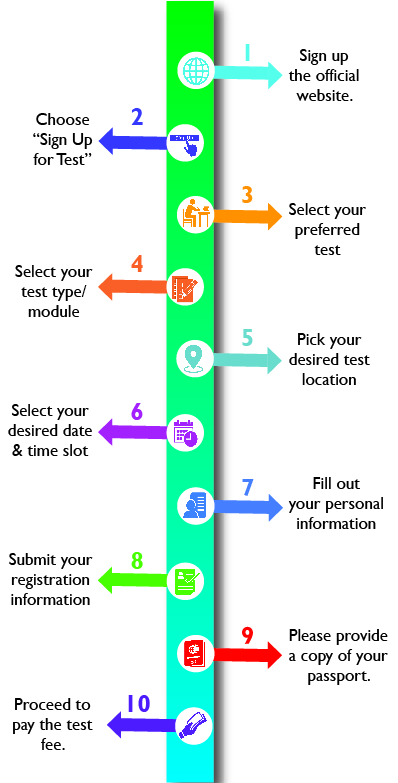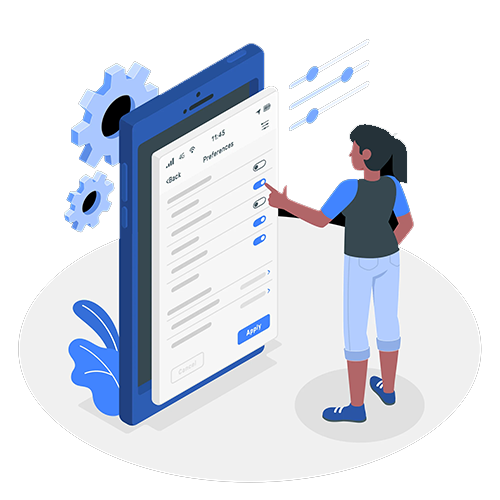The International English Language Testing System (IELTS) is a structured English proficiency exam that assesses the language skills of those who desire to study or work in environments where English is used as a medium of communication. It is accepted by a wide variety of educational institutions in countries all over the world, including the UK, IELTS in Australia, Canada, New Zealand, the USA, and the US itself.
IDP IELTS, a joint venture between IDP IELTS and Cambridge University Press & Assessment, is responsible for completely administering the IELTS test in India.
The IELTS test assesses all of your English skills (reading, writing, hearing, and speaking) and is designed to reflect how you will use English in your new life abroad for school, job, and leisure.
IELTS Academic Test: This is for persons who are applying for higher education or professional courses in another country.
IELTS General Training: You'll need this if you want to study or work in a country where English is spoken, such as Australia, Canada, or the United Kingdom.
IELTS Academic is available in two formats: computer-based and paper-based. Those who choose the IELTS computer-based examination complete the exam's Listening, Writing, and Reading components on a computer. While IELTS is a paper-based exam, participants must complete the Reading, Writing, and Listening components on paper using either HB pencils or a pen. The Speaking component of both forms of the test is completed face-to-face with a trained IELTS examiner.



Age Prerequisites - The IELTS administrators (IDP or British Council) do not specify an age restriction; nonetheless, applicants under the age of 16 are not permitted. Although they can also take the test if they want to.
Educational Eligibility - Anyone who wants to study or work in another country may take the IELTS IDP (both Academic and General Training). It is available to people of various educational levels who want to show off their English language skills. You may take the IELTS test whether you have finished high school, a bachelor's degree, or any other level of study. The test is meant to be accessible to people of all educational levels, allowing anyone to demonstrate their English language ability.
Candidates should, however, carefully examine the qualifying conditions specified by the educational institution or organisation to which they are applying.
It is a test designed to assess the English language proficiency of non-native English speakers. The IELTS is available in two versions: Academic and General Training.
IELTS is divided into four sections: Listening, Reading, Writing, and Speaking. Here is a breakdown of what each of these sections entails:
Listening (30 minutes) - This section is divided into four recorded monologues and conversations. It includes a variety of question types such as multiple choice, matching, plan/map/diagram labelling, form/note/table/flow-chart/summary completion, and sentence completion.
Reading (60 minutes) - This section consists of three long texts, which range from descriptive and factual to discursive and analytical. The Academic version includes three long texts, which range from descriptive and factual to discursive and analytical. These are taken from books, journals, magazines, and newspapers. The General Training version requires candidates to read extracts from books, magazines, newspapers, notices, advertisements, company handbooks, and guidelines.
Writing (60 minutes) - In the Academic version, Task 1 requires you to describe some visual information (graph/table/chart/diagram) in your own words, and Task 2 requires you to write an essay in response to a point of view, argument, or problem. In the General Training version, Task 1 requires you to write a letter (formal, semi-formal, or informal), and Task 2 is an essay in response to a point of view, argument, or problem.
Speaking (11 to 14 minutes) - The speaking component assesses your use of spoken English. Every test is recorded. The Speaking component is delivered in such a way that it does not allow people to rehearse set responses beforehand. It consists of three parts: a) Introduction and interview; b) Long turn (you are given a task card and you have to talk about it for 1-2 minutes); c) Discussion on topics related to the task card.
The total test time is 2 hours and 45 minutes. The Listening, Reading, and Writing components are always completed in one day. Depending on the test center, the Speaking test may be taken up to 7 days before or after the test date.
Remember that the specific format and content of the test may vary slightly over time, and it is best to check the most recent guidelines from the official IELTS website or from the organisation where you plan to take the test.
Four recorded monologues and conversations
The first two sections are set in everyday social contexts
The final two sections are set in educational and training contexts
Number of Questions: 40
Three extensive reading assignments with accompanying activities
The texts vary from those that are descriptive and factual to those that are discursive and analytical. Contains content that is not in spoken form, such as drawings, graphs, or diagrams.
The Academic Module of the IELTS Test consists of three lengthy readings that vary from factual and descriptive to discursive and analytical in nature.
These are excerpts from a variety of publications, including books, journals, magazines, and newspapers. The IELTS General Training Test consists of reading passages taken from a variety of sources, including books, periodicals, newspapers, notices, advertising, corporate handbooks, and instructions.
These are the kinds of things that, if you live in an English-speaking area, you will probably come across on a regular basis.
IELTS Academic: a. Describe a graph, table, chart, or diagram (150 words); b. Discuss a point of view, argument, or problem (250 words)
IELTS General Training: a. Write a letter, explain a situation, or request information (150 words), b. Compose an essay (250 words minimum) in which you respond to a viewpoint, argument, or issue.
Interview conducted in person
consists of brief inquiries, extended conversations on a subject that is already well-known, and a well-organized discussion.
You should go to the official IELTS website or get in touch with an authorized test centre for information that is both the most accurate and the most up-to-date.
IELTS exam dates are accessible all year. To accommodate the high number of test takers wanting to register for the IELTS exam, the IELTS test dates for the computer-delivered test are accessible seven days a week and up to three times a day.
The IDP exam dates for the IELTS Paper-delivered test are available up to four times each month, for a total of 48 set test days in a calendar year.
Candidates must first go to the official IDP IELTS India website, choose their chosen IELTS test dates, and then complete the IELTS registration procedure.
In India, IDP operates many IELTS test centres. We recommend that you register ahead of time so that you can choose your preferred day and time frame.
Ahmedabad, Amritsar, Bathinda, Bengaluru, Chandigarh, Chennai, Coimbatore, Delhi, Gurugram, Hyderabad, Jaipur, Jalandhar, Kochi, Ludhiana, Mumbai, Noida, Pune, Surat, Thane, Vadodara, Vijayawada.


According to the official website, the IELTS Score Report includes the following components:
|
IELTS Sections |
Minimum IELTS Scores |
Maximum IELTS Scores |
|
Listening |
4.5 |
9 |
|
Reading |
4.5 |
9 |
|
Writing |
5.0 |
9 |
|
Speaking |
5.5 |
9 |
|
Total Marks |
19.5 |
36 |
Candidates will only get a single copy of the Test Report Form. On the other hand, the administrative body will send your IELTS score (TRF) to up to five colleges that you have selected in the IELTS application form that you have submitted.
The examination may or may not require the use of watches, and this may vary from the testing center to the testing center. Candidates are often not permitted to use wristwatches throughout the test. This is done to assure fairness and avoid any cheating or diversions. It is crucial to remember, however, that each test center may have its own set of rules and restrictions; therefore, it is best to examine the instructions offered by the test center where you want to take the IELTS exam. If you need to keep track of time throughout the exam, the test center will normally have clocks accessible to all applicants.
If a candidate registers for the test but does not show up to take it, he will be considered absent, and he will not be eligible for a refund.
Since the system automatically creates the date of the speaking test, it is not possible to change it.
If your passport has not yet expired, you may use it on the day of the exam; if it has, you will need to rearrange the date of your IELTS test and carry a valid passport with you to the testing facility.
A score of seven on the IELTS is not very difficult to get. Most students score in the 5–6 band range; thus, applicants may increase their scores by focusing more on their weak areas. Whether it's a writing exam or another area where you're struggling, concentrate more on it, and you'll find it easier to earn a good grade.
For some candidates, it is very necessary to have both a guide and a consistent study schedule that includes predetermined periods in order to adequately prepare for the examination. The IELTS exam may seem like a piece of cake to many, but it might be tough for individuals after learning about its complexity. Candidates have the option to review the exam format.